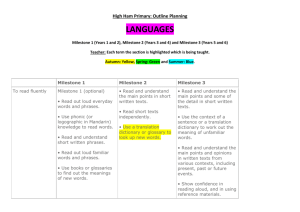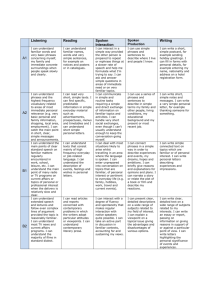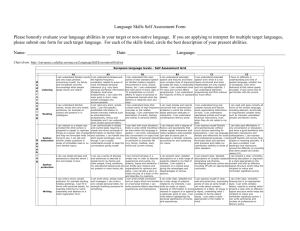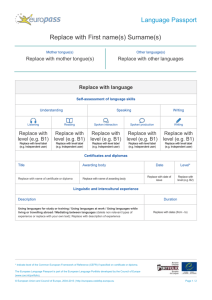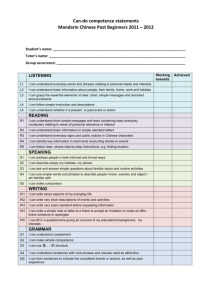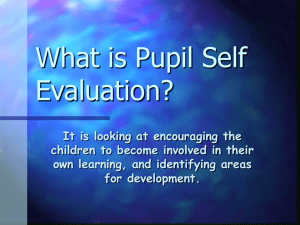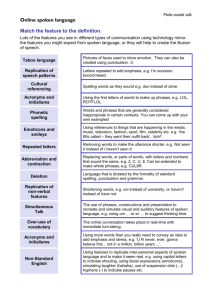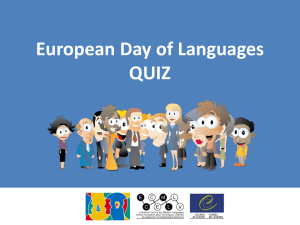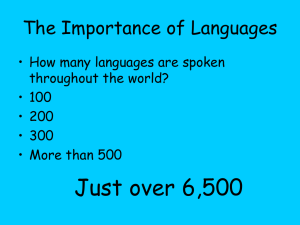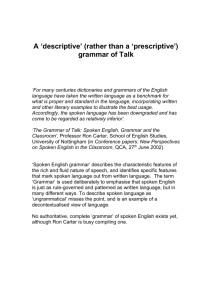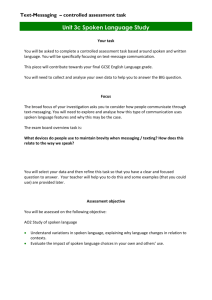Languages Policy - Measham Primary School
advertisement
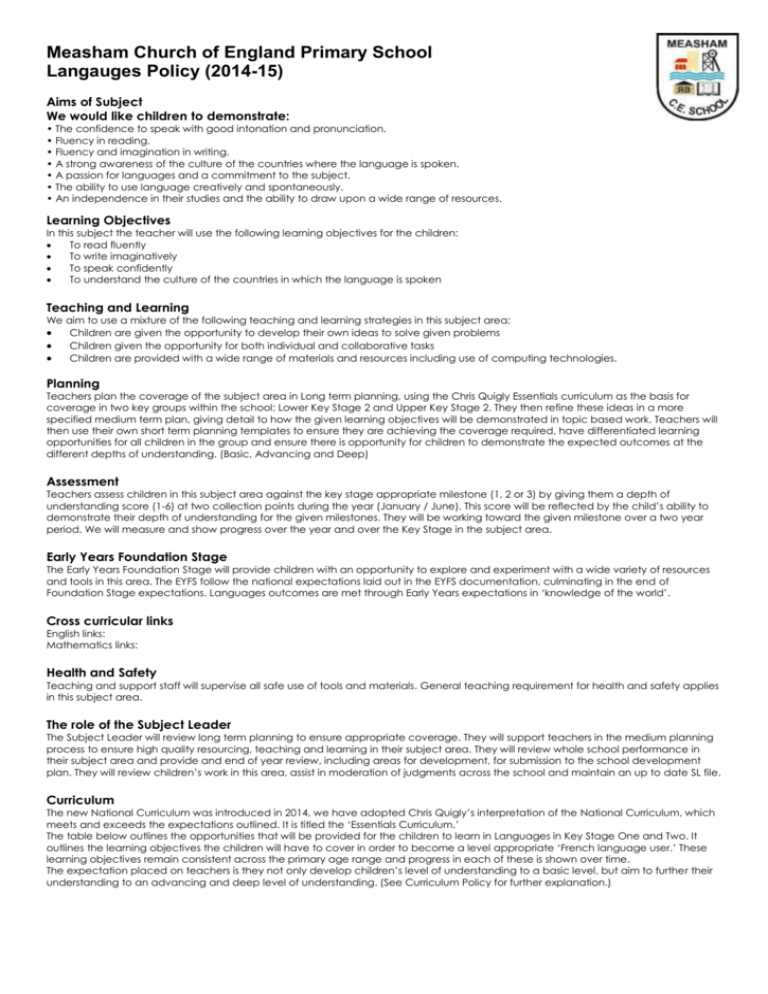
Measham Church of England Primary School Langauges Policy (2014-15) Aims of Subject We would like children to demonstrate: • The confidence to speak with good intonation and pronunciation. • Fluency in reading. • Fluency and imagination in writing. • A strong awareness of the culture of the countries where the language is spoken. • A passion for languages and a commitment to the subject. • The ability to use language creatively and spontaneously. • An independence in their studies and the ability to draw upon a wide range of resources. Learning Objectives In this subject the teacher will use the following learning objectives for the children: To read fluently To write imaginatively To speak confidently To understand the culture of the countries in which the language is spoken Teaching and Learning We aim to use a mixture of the following teaching and learning strategies in this subject area; Children are given the opportunity to develop their own ideas to solve given problems Children given the opportunity for both individual and collaborative tasks Children are provided with a wide range of materials and resources including use of computing technologies. Planning Teachers plan the coverage of the subject area in Long term planning, using the Chris Quigly Essentials curriculum as the basis for coverage in two key groups within the school; Lower Key Stage 2 and Upper Key Stage 2. They then refine these ideas in a more specified medium term plan, giving detail to how the given learning objectives will be demonstrated in topic based work. Teachers will then use their own short term planning templates to ensure they are achieving the coverage required, have differentiated learning opportunities for all children in the group and ensure there is opportunity for children to demonstrate the expected outcomes at the different depths of understanding. (Basic, Advancing and Deep) Assessment Teachers assess children in this subject area against the key stage appropriate milestone (1, 2 or 3) by giving them a depth of understanding score (1-6) at two collection points during the year (January / June). This score will be reflected by the child’s ability to demonstrate their depth of understanding for the given milestones. They will be working toward the given milestone over a two year period. We will measure and show progress over the year and over the Key Stage in the subject area. Early Years Foundation Stage The Early Years Foundation Stage will provide children with an opportunity to explore and experiment with a wide variety of resources and tools in this area. The EYFS follow the national expectations laid out in the EYFS documentation, culminating in the end of Foundation Stage expectations. Languages outcomes are met through Early Years expectations in ‘knowledge of the world’. Cross curricular links English links: Mathematics links: Health and Safety Teaching and support staff will supervise all safe use of tools and materials. General teaching requirement for health and safety applies in this subject area. The role of the Subject Leader The Subject Leader will review long term planning to ensure appropriate coverage. They will support teachers in the medium planning process to ensure high quality resourcing, teaching and learning in their subject area. They will review whole school performance in their subject area and provide and end of year review, including areas for development, for submission to the school development plan. They will review children’s work in this area, assist in moderation of judgments across the school and maintain an up to date SL file. Curriculum The new National Curriculum was introduced in 2014, we have adopted Chris Quigly’s interpretation of the National Curriculum, which meets and exceeds the expectations outlined. It is titled the ‘Essentials Curriculum.’ The table below outlines the opportunities that will be provided for the children to learn in Languages in Key Stage One and Two. It outlines the learning objectives the children will have to cover in order to become a level appropriate ‘French language user.’ These learning objectives remain consistent across the primary age range and progress in each of these is shown over time. The expectation placed on teachers is they not only develop children’s level of understanding to a basic level, but aim to further their understanding to an advancing and deep level of understanding. (See Curriculum Policy for further explanation.) Languages Essential Opportunities Key Stage 1 Essential Opportunities Key Stage 2 In the chosen modern language: (French) • Speak • Read • Write Look at the culture of the countries where the language is spoken. If an ancient language is chosen, read, translate and explore the culture of the time. Essential Learning Objectives Milestone 1 End of Year 2 Milestone 2 End of Year 4 Milestone 3 End of Year 6 To read fluently Read out loud everyday words and phrases. Use phonic (or logographic in Mandarin) knowledge to read words. Read and understand short written phrases. Read out loud familiar words and phrases. Use books or glossaries to find out the meanings of new words. Read and understand the main points in short written texts. Read short texts independently. Use a translation dictionary or glossary to look up new words. Read and understand the main points and some of the detail in short written texts. Use the context of a sentence or a translation dictionary to work out the meaning of unfamiliar words. Read and understand the main points and opinions in written texts from various contexts, including present, past or future events. Show confidence in reading aloud, and in using reference materials. To write imaginatively Write or copy everyday words correctly. Label items and choose appropriate words to complete short sentences. Write one or two short sentences. Write short phrases used in everyday conversations correctly. Write a few short sentences using familiar expressions. Express personal experiences and responses. Write short phrases from memory with spelling that is readily understandable. To speak confidently Understand a range of spoken phrases. Understand standard language (sometimes asking for words or phrases to be repeated). Answer simple questions and give basic information. Give responses to questions about everyday events. Pronounce words showing a knowledge of sound (or pitch in Mandarin) patterns. Understand the main points from spoken passages. Ask others to repeat words or phrases if necessary. Ask and answer simple questions and talk about interests. Take part in discussions and tasks. Demonstrate a growing vocabulary. To understand the culture of the countries in which the language is spoken Identify countries and communities where the language is spoken. Demonstrate some knowledge and understanding of the customs and features of the countries or communities where the language is spoken. Show awareness of the social conventions when speaking to someone. Describe with some interesting details some aspects of countries or communities where the language is spoken. Make comparisons between life in countries or communities where the language is spoken and this country. Write short texts on familiar topics. Use knowledge of grammar (or pitch in Mandarin) to enhance or change the meaning of phrases. Use dictionaries or glossaries to check words. Refer to recent experiences or future plans, as well as to everyday activities. Include imaginative and adventurous word choices. Convey meaning (although there may be some mistakes, the meaning can be understood with little or no difficulty). Use dictionaries or glossaries to check words. Understand the main points and opinions in spoken passages. Give a short prepared talk that includes opinions. Take part in conversations to seek and give information. Refer to recent experiences or future plans, everyday activities and interests. Vary language and produce extended responses. Be understood with little or no difficulty. Give detailed accounts of the customs, history and culture of the countries and communities where the language is spoken. Describe, with interesting detail, some similarities and differences between countries and communities where the language is spoken and this country. Optional Key Stage 1
